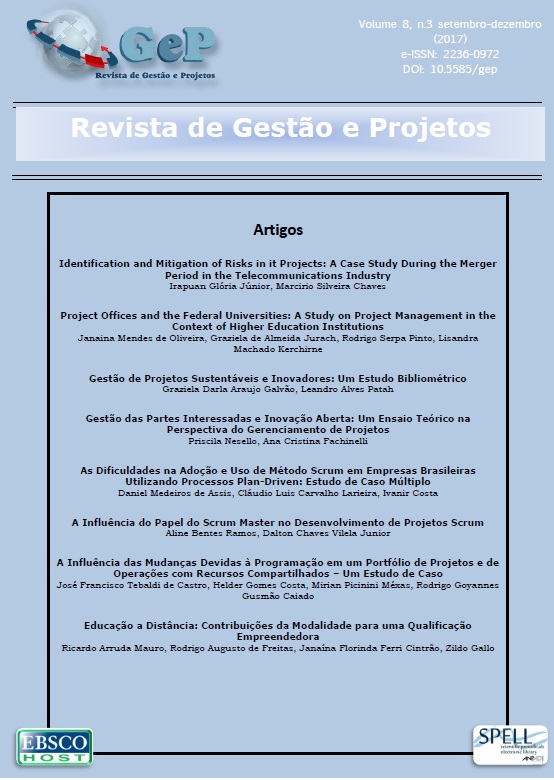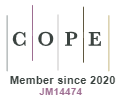Identification and Mitigation of Risks in it Projects: A Case Study During the Merger Period in the Telecommunications Industry
DOI:
https://doi.org/10.5585/gep.v8i3.581Palavras-chave:
Project Management, Risk Management, It Projects, Merger, Telecommunications, Risks, Case Study.Resumo
This paper identifies risks in IT projects in the merger period in telecommunications companies and proposes mitigation actions. It adopts an interpretive epistemology in an exploratory case study. The results include a list of 13 exclusive risks in IT projects in such a period and recommendations for mitigating the risks identified in the study. The theoretical contribution lies on the identification of 13 exclusive risks in IT projects in the merger period between two telecom companies, and the contribution to practice enables project managers to apply the findings identified and mitigations in risk management in IT projects in a similar setting.
Referências
Alao, Esther Monisola, Adebawojo, Oladipupo (2012), Risk and Uncertainty In Investiment Decisions: An Overview. Arabian Journal of Business and Management Review (OMAN Chapter), 2(4), 53-64.
ANATEL (2014). Agência Nacional de Telecomunicações. Available at www.anatel.gov.br/, Last visit February, 2014.
Aragonés-Beltrán, P., García-Melón, M., & Montesinos-Valera, J. (2017). How to assess stakeholders' influence in project management? A proposal based on the Analytic Network Process. International Journal of Project Management, 35(3), 451-462.
Baker, E. W., & Niederman, F. (2014). Integrating the IS functions after mergers and acquisitions: Analyzing business-IT alignment. The Journal of Strategic Information Systems, 23(2), 112-127.
Bannerman, Paul L (2007), Software Project Risk in the Public Sector, Proceedings of the 2007 Australian Software Engineering Conference (ASWEC'07).
Boehm, Barry W. (1991). Software Risk Management: Principles and Practices, IEEE Software, 32-41.
COSO - The Committee of Sponsoring Organizations of the Treadway Commission (2004). Enterprise Risk Management - Integrated Framework. Available at http://www.coso.org/-erm.htm Last visit, November, 2014
De Bakker, K., Boonstra, A., & Wortmann, H. (2010). Does risk management contribute to IT project success? A meta-analysis of empirical evidence. International Journal of Project Management, 28(5), 493-503.
De Wet, B., & Visser, J. K. (2013). An evaluation of software project risk management in South Africa, South African Journal of Industrial Engineering, 24, 14-29.
Eisenhardt, K. M. (1989). Building theories from case study research. Academy of Management Review, 14(4), 532-550.
El Emam, K., & Koru, A. G. (2008). A replicated survey of IT software project failures, Software, IEEE, 25(5), 84-90.
Feitosa, M. J. S., Silva, M. E., & Firmo, L. A. (2012). Fusões e aquisições empresariais no contexto brasileiro: o caso da OI e BRASIL TELECOM. Revista Razão Contábil & Finanças, 2(1).
FSP – Jornal Folha do Estado de São Paulo (2014). Available at www.folha.com.br, Last visit October, 2014.
Gallagher, B. P., Case, P. J., Creel, R. C., Kushner, S., Williams, R. C. (2005), A Taxonomy of Operational Risks, Carnegie Mellon – Software Engineering Institute, CMU/SEI-2005-TN-036, 1-40.
Gholami, S. (2012), Critical Risk Factors in Outsourced Support Projects of IT. Journal of Management Research, 4(1), 1–13. doi:10.5296/jmr.v4i1.939
Glória Júnior, I., & Chaves, M. S. (2015a). Identification and Mitigation of Risks associated with Stakeholders in IT Projects: A Case Study in the Period of Merger in the Telecoms Industry. Exacta, 13(1), 187-196.
Glória Júnior, I., & Chaves, M. S. (2015b). Analyzing Risks of Scope and Organizational Risks in IT Projects: A Case Study during the Merger Period in the Telecom Industry. Journal of Information Technology Management, 26(4), 1.
Glória Júnior, I., Oliveira, R., & Chaves, M. (2014). A Proposal for Using Web 2.0 Technologies in Scrum, ECIS - European Conference on Information Systems, 1 16.
Hartono, B., Sulistyo, S. R., Praftiwi, P. P., & Hasmoro, D. (2014). Project risk: Theoretical concepts and stakeholders' perspectives. International Journal of Project Management, 32(3), 400-411.
Hussein, A. (2009). The use of triangulation in social sciences research: Can qualitative and quantitative methods be combined. Journal of Comparative Social Work, 1(8), 1-12.
IPMA (2006), International Project Management Association - National Competence Baseline 3.0, International Project Management Association.
Jani, A. (2008). An experimental investigation of factors influencing perceived control over a failing IT Project. International Journal of Project Management, 26(7), 726 732.
Jani, A. (2010). Escalation of commitment in troubled IT projects: influence of project risk factors and self-efficacy on the perception of risk and the commitment to a failing project. International Journal of Project Management, 29(7), 934 945.
Khan, Q., and Ghayyur, S. (2010). Software Risks and Mitigation in Global Software Development, Journal of Theoretical & Applied Information Technology, 22, 58 69.
Khazanchi, D., & Arora, V. (2016). Evaluating Information Technology (IT) Integration Risk Prior to Mergers and Acquisitions (M&A). ISACA Journal, 1.
KPMG (2014), Pesquisa de Fusões e Aquisições - 3o. trimestre de 2013. Available at https://www.kpmg.com, Last visit January, 2014.
Lemes Júnior, A. B., Rigo, C. M., & Cherobim, A. P. M. S. (2005). Administração Financeira: princípios, fundamentos e práticas brasileiras (2ª Ed). Rio de Janeiro: Campus.
Mayer, N., & De Smet, D. (2017). Systematic Literature Review and ISO Standards analysis to Integrate IT Governance and Security Risk Management. International Journal for Infonomics (IJI), 10 (1), 1255-1263.
Pinna, M. C. C. de Abreu, & Arakaki, R. (2009), Arquitetura de Software: Uma Abordagem para Gestão de Riscos em Projetos de TI, Integração, Ano XV, Nr.57, 111-120
PMBoK, A. (2012). Guide to the project Management body of knowledge. Project Management Institute, Pennsylvania USA.
Ross, S. A., Westerfield, R. W, Jaffe, J. F. (2002). Administração financeira – Corporate Finance. São Paulo: Atlas.
Sarker, S., Xiao, X., Beaulieu, T. (2013). Qualitative Studies in Information Systems: A Critical, Review and Some Guiding Principles. MIS Quarterly, 37 (4) pp. iii-xviii.
Sauser, B. J., Reilly, R. R. & Shenhar, A. J. (2009). Why projects fail? How contingency theory can provide new insights – A comparative analysis of NASA’s Mars Climate Orbiter loss. International Journal of Project Management, 27 (7), 665-679.
Schmidt, R., Lyytinen, K., Keil, M., & Cule, P. (2001). Identifying software project risks: an international Delphi study, Journal of Management Information Systems, 17(4), 5-36.
Shehzad, B., Awan, K. M., Lali, M. I. U., & Aslam, W. (2017). Identification of Patterns in Failure of Software Projects. Journal of Information Science and Engineering, 33, 1465-1479.
Smyth, H.J., Morris, P.W.G. (2007). An epistemological evaluation on research into Project and their management: methodological issues. International Journal of Project Management, 25(4), 423-436.
TELECO (2014). Teleco Consultoria - Mercado. Available at www.teleco.com.br, Last visit October, 2014
Wallace, L., & Keil, M., Rai, A. (2004). How software project risk affects project performance: an investigation of the dimensions of risk and an exploratory model, Decision Sciences, 35(2), 289–321.
Yin, Robert. K. (2014). Case study research: Design and methods. Sage publications.
Zwikael, O., Pathak, R. D., Singh, G., & Ahmed, S. (2014). The moderating effect of risk on the relationship between planning and success. International Journal of Project Management, 32(3), 435-441.
Downloads
Publicado
Como Citar
Edição
Seção
- Resumo 722
- PDF/INGLÊS 1308







